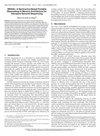以gpu为中心的LLM内存分层与NVIDIA Grace Hopper超级芯片
IF 1.4
3区 计算机科学
Q4 COMPUTER SCIENCE, HARDWARE & ARCHITECTURE
引用次数: 0
摘要
本研究研究了服务大型语言模型(llm)的性能,重点关注GPU和CPU之间的高带宽互连,使用真正的NVIDIA Grace Hopper超级芯片。该架构采用以GPU为中心的内存分级系统,包括包含GPU内存的性能层和包含主机内存的容量层。我们重新审视了LLM推理的传统流水线执行,利用通过NVLink连接的主机内存和GPU内存。对于Llama-3.1 8B基础(FP16)模型,这种以GPU为中心的分层存储系统满足预填充和解码的目标延迟要求,同时与内存中的情况相比,提高了吞吐量,其中所有模型权重都保持在GPU内存中。然而,即使使用nvlink连接的CPU内存,满足70B和405B等大型型号FP16模型的延迟限制仍然具有挑战性。为了解决这个问题,我们探索了模型量化(例如,AWQ)以及流水线执行的有效性。我们的评估表明,模型量化使流水线执行成为服务大型模型的可行解决方案。对于lama-3.1 70B和405B AWQ模型,我们表明,在满足延迟约束的情况下,与仅在内存中的情况相比,流水线执行分别实现了1.6倍和2.9倍的吞吐量提高。本文章由计算机程序翻译,如有差异,请以英文原文为准。
GPU-Centric Memory Tiering for LLM Serving With NVIDIA Grace Hopper Superchip
This study investigates the performance of serving large language models (LLMs) with a focus on the high-bandwidth interconnect between GPU and CPU using a real NVIDIA Grace Hopper Superchip. This architecture features a GPU-centric memory tiering system, comprising a performance tier with GPU memory and a capacity tier with host memory. We revisit a conventional pipelined execution for LLM inference, utilizing host memory connected via NVLink alongside GPU memory. For the Llama-3.1 8B base (FP16) model, such a GPU-centric tiered memory system meets the target latency requirements for both prefill and decoding while improving throughput compared to the in-memory case, where all model weights are maintained in GPU memory. However, even with NVLink-connected CPU memory, meeting latency constraints for large models like the 70B and 405B FP16 models remains challenging. To address this, we explore the efficacy of model quantization (e.g., AWQ) along with the pipelined execution. Our evaluation reveals that the model quantization makes the pipelined execution a viable solution for serving large models. For the Llama-3.1 70B and 405B AWQ models, we show that the pipelined execution achieves 1.6× and 2.9× throughput improvement, respectively, compared to the in-memory only case, while meeting the latency constraint.
求助全文
通过发布文献求助,成功后即可免费获取论文全文。
去求助
来源期刊

IEEE Computer Architecture Letters
COMPUTER SCIENCE, HARDWARE & ARCHITECTURE-
CiteScore
4.60
自引率
4.30%
发文量
29
期刊介绍:
IEEE Computer Architecture Letters is a rigorously peer-reviewed forum for publishing early, high-impact results in the areas of uni- and multiprocessor computer systems, computer architecture, microarchitecture, workload characterization, performance evaluation and simulation techniques, and power-aware computing. Submissions are welcomed on any topic in computer architecture, especially but not limited to: microprocessor and multiprocessor systems, microarchitecture and ILP processors, workload characterization, performance evaluation and simulation techniques, compiler-hardware and operating system-hardware interactions, interconnect architectures, memory and cache systems, power and thermal issues at the architecture level, I/O architectures and techniques, independent validation of previously published results, analysis of unsuccessful techniques, domain-specific processor architectures (e.g., embedded, graphics, network, etc.), real-time and high-availability architectures, reconfigurable systems.
 求助内容:
求助内容: 应助结果提醒方式:
应助结果提醒方式:


